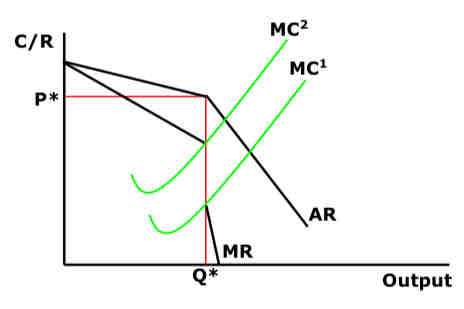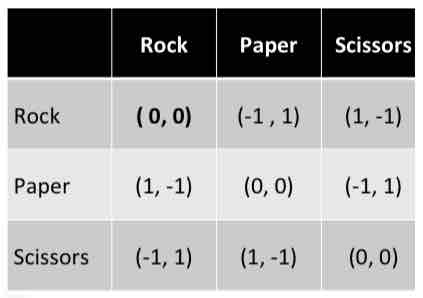Market Structure IV: Oligopoly
1/27
There's no tags or description
Looks like no tags are added yet.
Name | Mastery | Learn | Test | Matching | Spaced |
|---|
No study sessions yet.
28 Terms
what is an oligopoly?
a market dominated by a few large firms
what are the four main assumptions of an oligopoly?
barriers to entry
high conc ratio
differentiated goods
firms are highly independent
what is interdependence?
each firm must take account of its rivals’ behaviour + reactions
i.e. must act strategically
either cooperatively/ non-cooperatively
real life oligopoly examples:
TESCO dominates UK petrol market, followed by BP, Shell, ESSO
Cineworld dominates UK cinema market, followed by Odeon and Vue
William Hill dominates UK betting market, followed by bet365, Ladbrokes and Paddypower
Non-Cooperative Strategy I: The Kinked Demand Curve Model
The oligopolist thinks:
If I increase my price, my competitors will leave their own price unchanged, in order to take some of my market share
But:
If I decrease my price, my competitors will follow suit in order to preserve their own market shares
So the oligopolist believes his competitors will:
'Match price reductions but ignore price increases'
This gives rise to a kinked demand curve
MR has a discontinuity at the kink...
...because MR has twice the gradient of AR
Hence Q* is seen to be the profit-maximising level of output under a wide range of cost conditions from MC1 to MC2
So the firm will leave price and output unchanged, even when costs do change
This causes sticky prices...
(Paul Sweezy, 1939; Hall & Hitch, 1939)
So the oligopolist might compete on non-price factors instead...

analysis of the KDC model
criticisms of the KDC model
The KDC model does not explain how the original price, p*, was determined
i.e. it tells us prices will be rigid, but not whether they are likely to be high or low to begin with
in practice, many oligopolists do change prices (e.g. Tesco price check) so the KDC model would seem to be outdated
what is game theory?
a method of modelling the strategic interaction between firms in an oligopoly when the firms have incomplete information about the others’ intentions
what is a dominant strategy?
a strategy which always produces the kremlin for the firm, no matter which strategy is chosen by its rivals
what is nash equilibrium?
where each player’s chosen strategy maximises the pay-offs, given the other player’s choice, so that no player has an incentive to change its strategy
what is a payoff matrix?
a grid that illustrates the possible outcomes of two players’ actions
what is a zero sum game?
where a gain by one player is matched by a loss by another player
rock paper scissors - random strategy
In this game matter what both players choose, at least one of them can always improve their payoff by switching to a different choice.
If one of them wins the game, the loser can improve their payoff by switching.
If it's a tie, either player can improve their payoff by switching to a different choice.

use of game theory in analysing oligopolies
game theory examples revolve around the pay-offs that come from making different decisions.
this illustrates why firms are likely to compete if they cannot be sure that their competitor will consistently collude (& lack of communication). Even though this will not maximise returns.
illustration of interdependent decision making e.g. marketing, pricing or R&D
criticisms of game theory
assumption that firms are perfectly rational may be unrealistic
may work well as a mathematical model, but not based on behavioural evidence…and human behaviour – even that of a CEO – can be irrational as opposed to being precisely calculated
even when a game is played for multiple rounds and the players have established a ‘Nash equilibrium’, preferences can still change over time
first mover (change your strategy) advantage
gain customers
develop brand loyalty
no switching costs – costs incurred by late entrants to entice customers to switch
first mover (change your strategy first) disadvantage
free rider effects (R&D, marketing and awareness)
high marketing costs to raise awareness
second mover advantage
high financial uncertainty
examples of first mover advantage
AWS has become the biggest technology infrastructure provider in the world — and it is also the fastest growing and most profitable part of Amazon

what are the types of cooperative strategies?
cartel
collusion
tacit collusion
what is a cartel?
an agreement between so or more firms to fix price and/or output
what is collusion?
a secret agreement between firms in a cartel to fix prices and/or output
what is tacit collusion?
where firms refrain from price competition, but without any communication or formal agreement
the intention of coordinating price and output is to:
mimic the benefits of being a monopoly, hence maximising joint profits
Oligopolists will raise their prices simultaneously, each firm moving along a continuously inelastic AR curve
why are cartels inherently unstable and rarely last for long?
Cheating
Each firm now knows the other one will price high, so…
Each firm thinks it can selfishly maximise its own profit by slightly undercutting its rivals and pricing low
this situation does not last long because….
Illegality
Fines of up to 10% turnover
Leniency – heightens the instability
Jail sentences of up to 5 year
types of collusion
overt collusion
tacit collusion
overt collusion
e.g. that is spoken, open or traceable
Pricing agreements
Output quotes / market share
Information sharing such as technical data
Agreed limits to marketing expenditure
Joint R&D projects
https://www.tutor2u.net/economics/reference/oligopoly-collusion
tacit collusion
occurs where firms undertake actions that are likely to minimise a competitive response, without explicit communication and normally through repeated observations of behaviour e.g. price leadership of BA
AKA Price Leadership
one dominant firm in the industry takes the lead in setting price…
…the others simply follow suit
✔ Major mortgage lenders
✔ Petrol stations
not illegal as firms aren’t actively conspiring
common features of oligopoly
price rigidity
(to avoid price wars)
dominant strategy of low price and high output
non-price competition
(advertising and brand loyalty, sales promos, R&D, etc, to acquire new customers but without undermining revenues)
temptation to collude and form a cartel
(though these are naturally unstable and are made even more wobbly by illegality and ‘leniency’ rules)
continuously inelastic → rigid prices
leniency → more likely for behaviour to carry on.